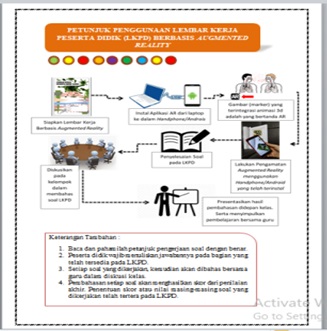
Design of Student Worksheets Based on Augmented Reality
Abstract
Keywords
Full Text:
PDFReferences
Ady, S. (2014). Augmented reality tata surya sebagai sarana pembelajaran interaktif bagi peserta didik sekolah dasar berbasis android. Journal of Educational Sciences, 1(1), 12-17.
Ammatia, R. (2012). Augmented reality. Bandung : Institut Teknologi Telkom.
Bitter, G., & Coral, A., (2014). The pedagogical potential of augmented reality apps. Case study : Arizona State University. International Journal of Engineering Science Invention, 19(1), 43-48.
Chen, D. R., Chen, M. Y., Huang, T. C., & Hsu, W. P., (2013). Developing a Mobile Learning System in Augmented Reality Context. Case Study : Department of Information Management. National Taichung University of Science and Technology. Taiwan. International Journal of Distributed Sensor Networks, 11, 101-105.
Danacorn, N., Hishamuddin, A. R., Mohamad, B., & Noor, D. A. H. (2013). Mobile augmented reality. Elsevier - The Potential for Education. 145(1), 145-152.
Dedy, R., & Arief, B. (2016). Developing learning media based on augmented reality (AR) to improve learning motivation. Journal of Education Teaching and Learning, 1(2), 89-94.
Depdiknas., (2008). Pengembangan Bahan Ajar. Jakarta : Depdiknas.
Gusmida, R., & Nur, I. (2017). The development of learning media for the kinetic theory of gases using the ADDIE model with augmented reality. Journal of Educational Sciences, 1(1), 1-10.
Haryanto, T., Helen, S. P., & Hengky, A. (2017). Aplikasi augmented reality sebagai media pembelajaran materi pembelahan sel dalam mata pelajaran biologi program studi teknik informatika universitas tanjungpura. Jurnal Sistem dan Teknologi Informasi, 1(2). 10-19.
Hendripides, S., & Hikmah, N. (2018). development of innovative teaching materials through scientific approach. economic education studies program. Journal of Educational Sciences, 2(2), 14-22.
Mustaqim, I., & Kurniawan, N. (2017). Pengembangan media pembelajaran berbasis augmented reality. Case study : Universitas Negeri Yogyakarta. .Jurnal Edukasi Elektro, 43(2), 34-37.
Isra, Y. K., Gibran., & Mitri, I. (2018). Development of worksheet based on high-order thinking skills to improve high-order thinking skills of the students. Journal of Educational Sciences. 2(1), 37-45.
Khan, T., Jacques, O., & Kevin, J. (2019). The impact of an augmented reality application on learning motivation of students. Case Study : Department of Information Systems University of Cape Town. Hindawi Advances in Human-Computer Interaction Article, 52(1), 265-271.
Malinka, I., & George, I. (2011). Enhancement of learning and teaching in computer graphics through marker augmented reality technology. International Journal on UNCAA, l(1), 123-126.
Marno, & Idris, M. (2012). Strategi dan Metode Pengajaran. Yogyakarta: ArRuzz.
Mauludin, R., Anggi, S. S., Hafiz, M. (2017). penerapan augmented reality sebagai media pembelajaran sistem pencernaan pada manusia dalam mata pelajaran biologi program studi teknik informatika fakultas teknik universitas tanjungpura. Jurnal Edukasi dan Penelitian Informatika, 3(2), 67-75.
Mbulu, & Joseph, J. (2004). Pengembangan Bahan Ajar. Malang : Perpustakaan Digital Elang Mas.
Nasir, M., Rizo, B.P., & Riwayani. (2018). Design and development of physics learning media of three dimensional animation using blender applications on atomic core material. Journal of Educational Sciences, 2(2), 23-32.
Novitasari, D., & Fajar, A. (2017). Pengembangan augmented reality berbasis android materi sistem pernapasan manusia untuk siswa kelas XI IPA SMA Negeri 1 Porong. Case Study : Universitas Negeri Surabaya. Jurnal Mahasiswa Teknologi Pendidikan, 1(1), 67-71.
Nurina, Amy, T., & Mashjudi. (2012). Pengembangan lembar kegiatan siswa (lks) pada materi sistem sirkulasi manusia kelas XI. Jurnal Universitas Negeri Malang. 23(1), 102-111.
Prastowo, A., (2013). Panduan kreatif membuat bahan ajar inovatif. Yogyakarta : Diva Press.
Sannikov, S., Fedor, Z., Pavel, C., & Pavel, R. (2015). Interactive educational content based on augmented reality and 3d visualization. Elsevier, 66(1), 720-729.
Suhertian, J., & Risa, H. (2017). Pengembangan aplikasi mobile augmented reality sebagai media pembelajaran biologi konsep sel. Jurnal Sains dan Informatika, l(3), 170-173.
Wahyu, D. H., Dedi, K., & Saida, U., (2017). Pembelajaran organisasi makhluk hidup berbasis gamification menggunakan mobile augmented reality. Case study: University of Malang. JinoTEP, 4(1), 43-47.
Wenggita, Fauzi, B., & Andreas, H. P. (2016). Pengembangan media pembelajaran berbasis multimedia augmented reality pada pokok bahasan alat optik. Prosiding Seminar Nasinal Fisika, 2(1), 121-129
Yuliono, T., Peduk, R., & Sarwanto. (2017). Keefektifan media pemelajaran augmented reality terhadap penguasaan konsep sistem pencernaan manusia universitas sebelas maret surakarta. Jurnal Pendidikan Dasar, 8(1), 18-25
DOI: http://dx.doi.org/10.31258/jes.4.1.p.176-186
Refbacks
- There are currently no refbacks.
Copyright (c) 2020 Ade Diana Kharisma, Wan Syafii, Zulfarina Zulfarina

This work is licensed under a Creative Commons Attribution 4.0 International License.
Publisher: FKIP Universitas Riau












